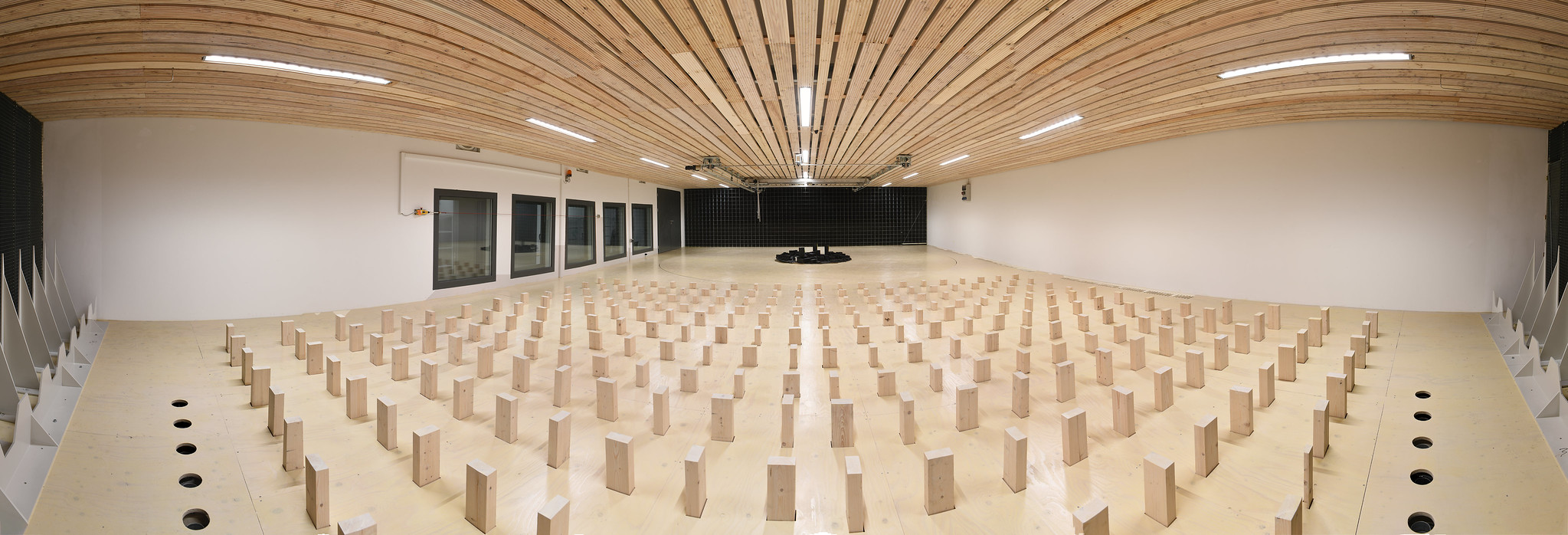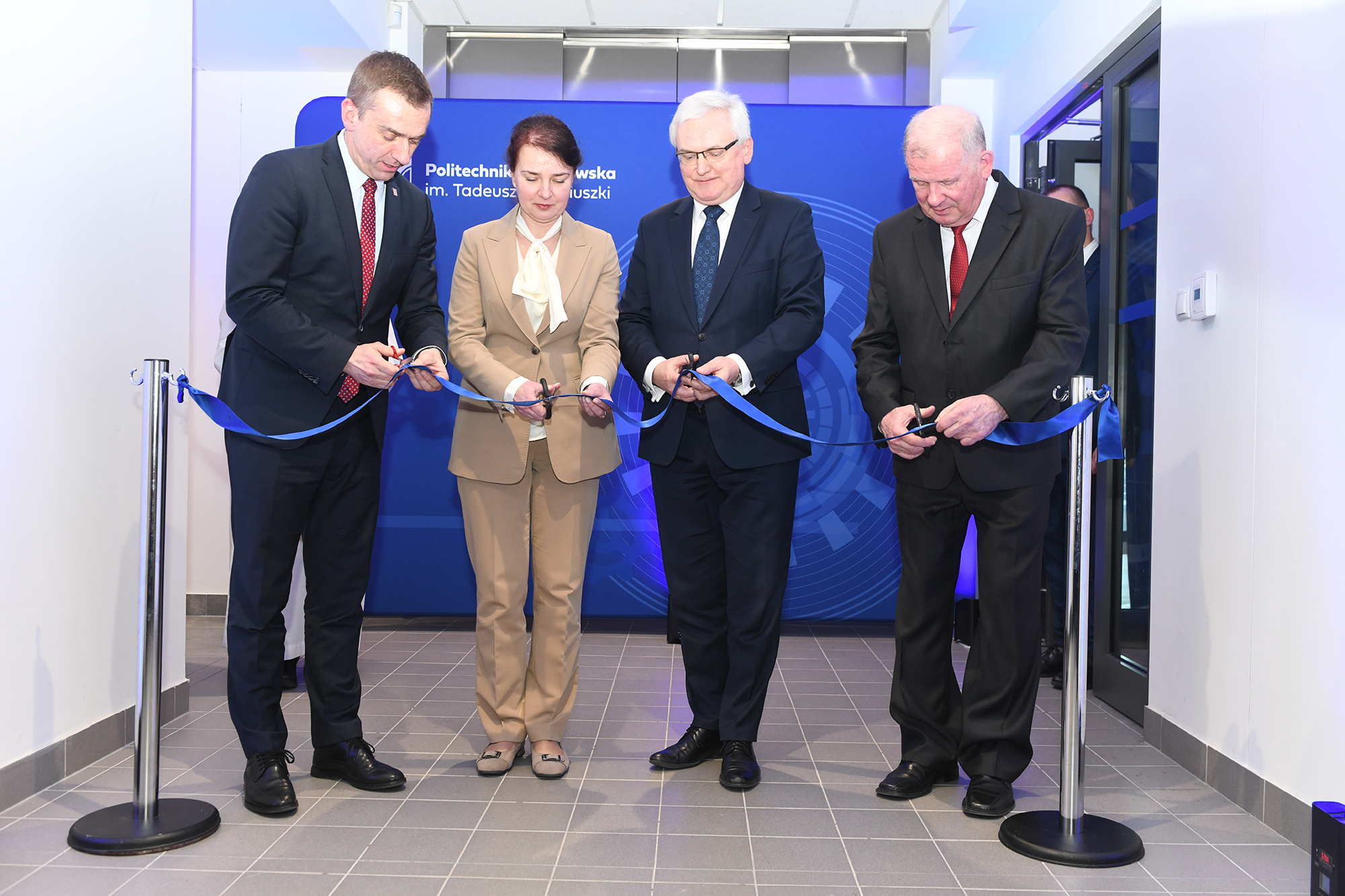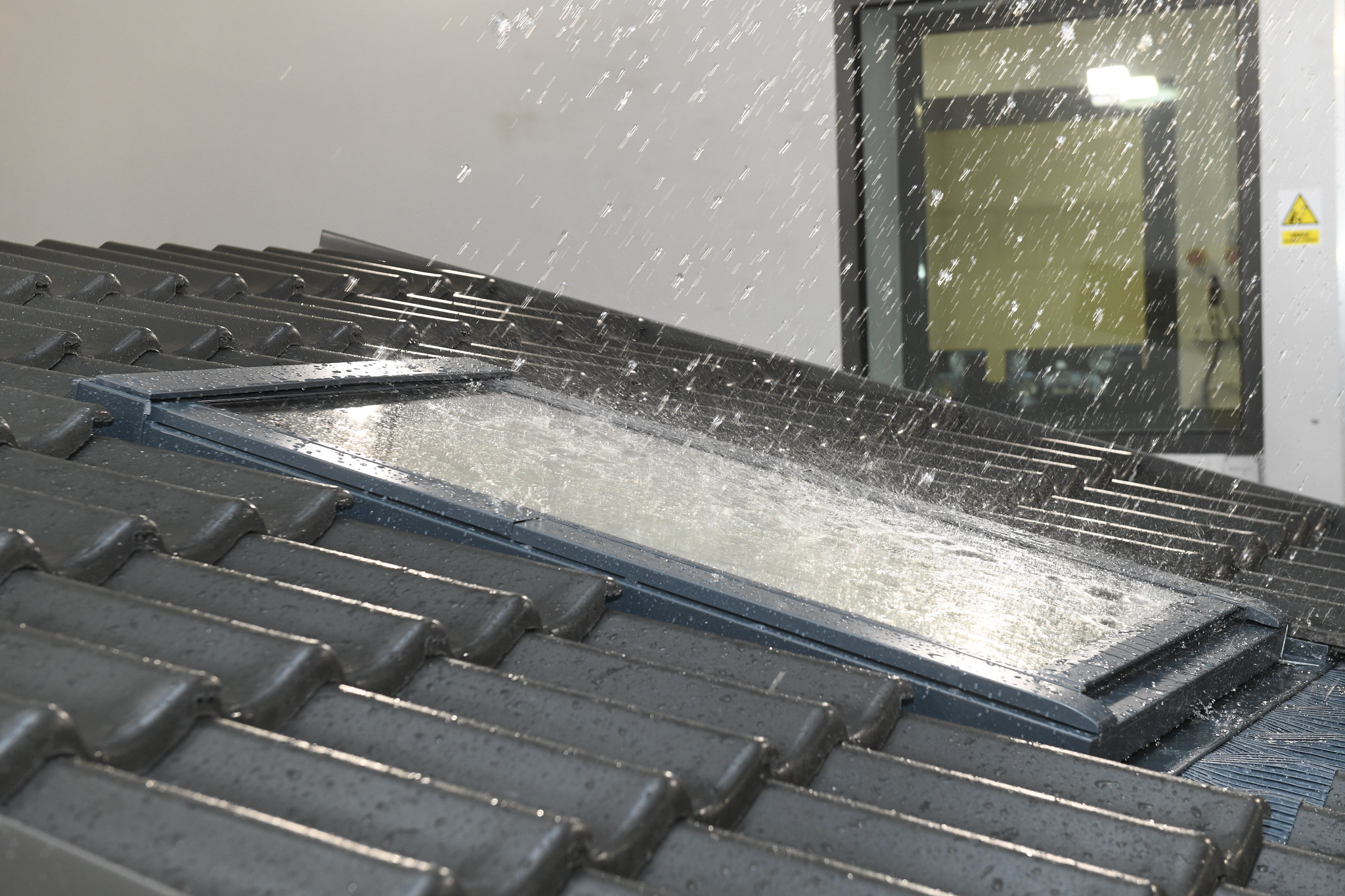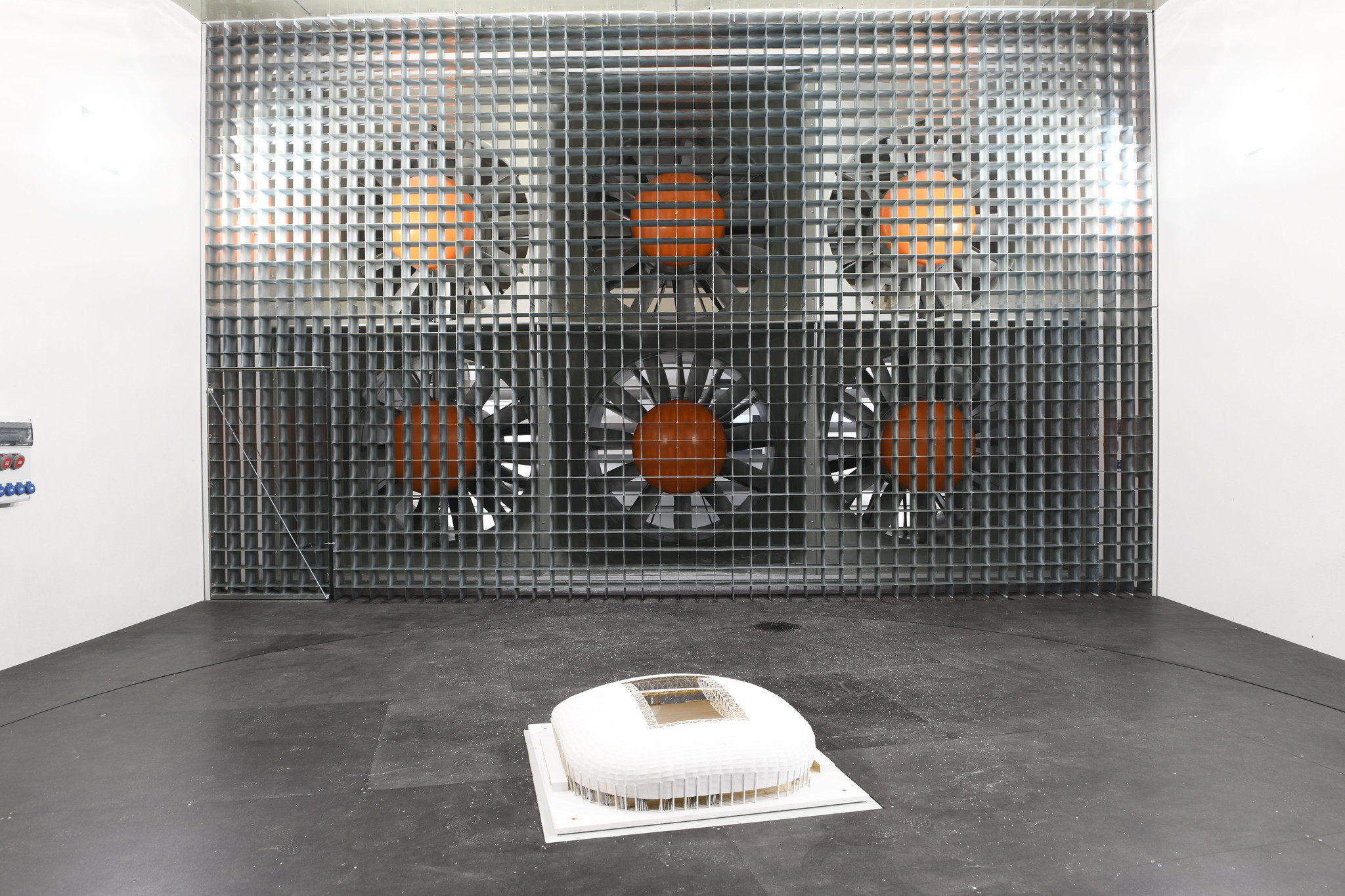A new Laboratory of Environmental Aerodynamics has been opened at the Cracow University of Technology. It is a unique tool on a global scale in the fight for clean air – not only in Krakow and Małopolska, but also in other regions of the country. The Laboratory's innovative, proprietary infrastructure will enable the specialists at the University to conduct research in the fields of wind engineering, snow engineering and environmental engineering, including urban ventilation, pollutant transport, dynamic effects on smog, air exchange and regeneration systems. The Laboratory, which has impressive wind tunnels at its heart, will also be used to analyse environmental and climatic impacts (such as violent winds, torrential rain or heavy snow) on structures, buildings and people's safety.
It will also be able to test innovative solutions for the wind energy, construction materials and related products markets. The new centre is also ready to take on non-standard engineering challenges. It can serve, for example, athletes or emergency services for training in changing weather conditions. Businesses, local authorities and institutions, including Polish business leaders Fakro and Maspex, as well as the Polish Ski Association, have already started cooperating with the Laboratory.

Strategic investment – for the University, for Krakow, and Lesser Poland

– The Laboratory of Environmental Aerodynamics is the largest investment of the Cracow University of Technology in recent years - strategic for the development of the University, our scientists and students, but also extremely important for Krakow, Lesser Poland and other parts of the country. The Laboratory's research capabilities will support municipal authorities in the arduous struggle for clean air for residents of cities and regions – says Professor Andrzej Szarata, Rector of the Cracow University of Technology.
Worth more than PLN 34 million, the new Laboratory at the Cracow University of Technology was built with the support of EU funds obtained by the University from the Lesser Poland Voivodeship's Regional Operational Programme for 2020-2024. EU funding totalled PLN 17,460,966, while the remaining funds for the construction came from the budget of the University and the Faculty of Civil Engineering at the Cracow University of Technology (the new unit is a part of it). The opening of the Laboratory concludes several decades of research experience of the University's experts headed by Professor Andrzej Flaga. The founder of the Polish school of wind engineering, structure aerodynamics and snow engineering created the Laboratory of Wind Engineering with a wind tunnel at the Cracow University of Technology nearly 25 years ago. However, its parameters were sufficient mainly for model research. -The growing scientific challenges, but also the increasing needs coming from the municipalities and the world of economy, gave birth to the idea of building a new research centre with incomparably greater capabilities, including those that will allow us to face the problem of combating smog. – says Professor Andrzej Flaga.
The Laboratory of Environmental Aerodynamics was built on the University's campus in Czyżyny at 37 Jana Pawła II Avenue. It is a three-storey building (including one underground storey) with an area of 1,665 m2 and a volume of 11,776 m3. The key infrastructure of the Laboratory includes two large closed-circuit wind tunnels, each equipped with two measurement spaces and a diverse system of fans (with original design and geometry, vibration-insulated, with confusors and diffusers). The resources of the new Laboratory also include, among others, rotary tables of original design, automated and vibration-isolated; steering systems of original design and geometry with the possibility of adjusting the angle of rotation of the steering wheels around their axes; complex, automated devices for simulating rainfall, fog precipitation or precipitation of fragmented ice crystals (frost) in conditions of blowing wind; complex, automated devices for simulating artificial snowfall; an automated device for measuring the power and torque of wind turbines with a vertical or horizontal axis of rotation of the rotor.
– The new Laboratory is a modern, striking-looking building with unique research instruments originally designed by our university engineers and produced by Polish companies. No one else in the world has such innovative and pioneering research tools at their disposal as we now have in Małopolska – points out the University's Rector, Professor Andrzej Szarata. – The new unit at the Cracow University of Technology offers a wide range of research in areas whose importance for science, but first and foremost for social and economic life, will continue to grow, because they concern, among other things, urban ventilation and the fight for clean air, renewable energy, sustainable development and environmental impacts caused, inter alia, by climate change - on people, buildings and structures.
– The opening of the Laboratory of Environmental Aerodynamics is, of course, the culmination of the many years of struggle that went into the creation of this project, but above all, it is a moment that opens up an excellent prospect of cooperation with various communities and scientific development, not only for our staff but also for other research centres. It is, of course, an excellent opportunity for collaboration with a wide range of industries. Finally, it is an excellent prospect for successful cooperation with municipal entities. Given its research potential, the Laboratory is a great opportunity for more sustainable development in the region and, therefore, a chance to improve the quality of life for the inhabitants of the region. We are absolutely sure that the Laboratory's research potential and the capabilities of the team working in this Laboratory under the watchful eye of Professor Andrzej Flaga, have the potential to carry out unique research, very ambitious and very advanced strategic research projects – said the Dean of the Faculty of Civil Engineering, dr hab. inż. Lucyna Domagała, Professor of CUT.
A wealth of research opportunities – in the fight for clean air for residents of cities and regions
The scientific and research agenda of the new Laboratory includes several dozen research services, including urban ventilation channels. The results of research and analyses carried out by the Laboratory in this area can provide planners and designers with valuable knowledge for designing new settlements, modernising existing ones, or constructing new buildings (especially tall ones). They will also be used by local government units (cities, municipalities, districts, voivodships) to create land use plans and to formulate other formal and spatial conditions for the development of urbanised areas (e.g. to create provisions in local land use plans, studies of land use conditions and directions). Based on the results of the research carried out in the Laboratory, it will be possible, among other things, to assess the effectiveness of the proposed solutions at an early stage of the decision-making process in terms of programming, planning and design.
See the Laboratory's research capabilities in the photos
In the new Laboratory it will be possible, among other things, to:
- develop wind maps - a system of air exchange and regeneration (using analyses of long-term data collected from meteorological stations and measurements made in the field with specialised equipment), such maps take into account natural airflow channels, streams that ventilate built-up areas - so-called aerosanitary channels;
- conduct research (in a wind tunnel) on the wind speed field of selected areas to create a comprehensive wind map for them, useful for architectural and urban design and the establishment of land use plans;
- conduct research (in the wind tunnel) on air mass movements, particularly the ventilation of built-up areas (with simulations of the movement of air masses under given boundary conditions, identification of the air velocity field, analysis of the stages of dispersion and movement of air masses);
- create concepts for possible spatial solutions to improve the natural conditions for air exchange and regeneration, based on research into the possibilities of dynamically forcing air mass movements and identifying the most favourable locations for elements forcing such air movements (e.g. large-scale fans);
- identify air mass contamination - the spread of smog and pollution over built-up areas; develop systems to predict and prevent health risks;
- make models for the study of various building projects with their surroundings, enabling analysis of aerodynamic phenomena;
- carry out model tests and studies of local wind action on the external walls of buildings (including roofs), pressure distribution maps, force and moment envelopes as a basis for the design and/or optimisation of building structures (windows, curtain walls, wall and roof covering elements, advertisements);
- carry out modelling research and pedestrian level wind speed studies - to assess the wind comfort of pedestrians in the analysed area, in particular in the vicinity of: building entrances, restaurant gardens, parks, recreation elements, and public areas;
- develop topographic maps - computer spatial models of the terrain that take into account the topography and roughness of the terrain, resulting from the forms of land surface;
- conduct climatic research: simulations of rain and/or snowfall and wind affecting roofing elements, ventilation and rainwater drainage systems and window (slope) joinery;
- investigate icing of building elements and engineering structures on a 1:1 scale;
- test wind turbines (model scale) and small-scale wind turbines/generators on a 1:1 scale.
 |
 |
Wind tunnels at the heart of the new Laboratory
The key elements of the research infrastructure of the Laboratory of Environmental Aerodynamics are:
- Wind tunnel for wind energy and building aerodynamics (TA1) – with two measuring spaces – lower (9.7 m wide x 2.3 m high x 17.7 m overall length) and the upper one (9.7 m wide x 3.3 m high x 12 m overall length) and three fans next to each other (each with a diameter of 2.92 m and a weight of 8.8 tons, a rotational speed of 550 rpm, a nominal power of 204.3 kW and a nominal capacity of 669 m3/s). The nominal highest average air velocity in the tunnel is 30 m/s.
Primary area of application: studies of the effects of wind on high-rise buildings, bridges and footbridges, buildings and large-area roofs; studies of pressure distributions on building surfaces; aeroelastic studies; urban ventilation, pollution transport; studies of wind power plants, technical infrastructure components (ventilation and air conditioning), façade components, roofs (spires, chimneys), engineering structures; - Climatic wind tunnel for environmental engineering (TA2) - with two measuring spaces - lower (width 7.9m x height 4.05 m x total length 16.8 m) and the upper one (width 7.9m x height 4.1 m x total length 12.9 m,) and 6 fans in 2 rows (each with a diameter of 2.1 m and a weight of 6 tons, a rotational speed of 745 rpm, a nominal power of 126.7 kW and a nominal capacity of 707 m3/s).
The nominal highest average air velocity in the tunnel is 20 m/s.
Primary area of application: climatic studies including simulation of wind, rain (from drizzle to torrential rain), air temperature change from -10°C to +25°C, simulation of icing and thawing cycles (set of infrared radiators) of elements of buildings and structures, engineering structures, façade sections, wind turbines, power lines; experimental studies of snow load on large-area roofs; identification of stagnation and turbulence zones in complex urban systems; - Flow visualisation wind tunnel (TA3) – with closed and open measurement space (Eiffel-type tunnel; working space width 1.0 m x height 1.0 m x total length 3.5 m). The nominal highest average air velocity: 20 m/s;
Primary intended applications: study of air velocity distribution around objects; visualisation of flow in the form of velocity vector field around objects by Particle Image Velocimetry (PIV) and other methods.
Pandemic challenges overcome
Construction of the Laboratory began in autumn 2020. The first shovel was symbolically dug by the then Rector of CUT, Professor Andrzej Białkiewicz and the Dean of the Faculty of Civil Engineering, Professor Andrzej Szarata (the current Rector). The general contractor for the investment was Zakład Techniczno-Budowlany sp. z. o. o. Polbau.
The COVID-19 pandemic, followed by the war in Ukraine, caused considerable difficulties during the construction process related to, among others, a sharp increase in the prices of construction materials and services, a slowdown in supplies, etc. The construction of the Laboratory was completed with such a magnificent result thanks to the tremendous work and determination of many people under the leadership of Professor Andrzej Flaga, dr. inż. arch. Łukasz Flaga and the entire team of the Laboratory of Wind Engineering. They received significant support from specialists from both the technical and financial departments of the University.
The official opening of the new Laboratory took place on January 30 2024, with the participation of numerous representatives of regional and local authorities, including the Małopolska Voivode Krzysztof Klęczar, Marshal Józef Gawron, the mayors of Żywiec - Antoni Szlagor and Rabka-Zdrój - Leszek Świder, as well as institutions (including the Łukasiewicz Research Network – Institute of Ceramics and Building Materials, Polish Ski Association, Polish Olympic Committee) and businesses, with which the University will develop cooperation based on the rich research potential of the new acquisition at the Faculty of Civil Engineering. Authorities of the Cracow University of Technology, faculties, non-departmental units and university administration were also amply represented.
The Laboratory of Environmental Aerodynamics of the Cracow University of Technology was implemented as a project RPMP.01.01.00-12-0141/18 – co-financed from the Regional Operational Programme of the Małopolska Voivodeship for 2014-2020; Priority Axis 1 – Knowledge Economy; Measure 1.1 – Research infrastructure of the science sector.
.




